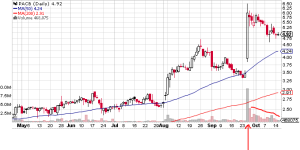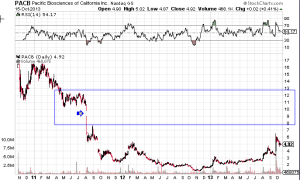
Changing Dynamics of the Sequencing World
This comes on the heels of Roche-PacBio deal announced recently. Also, shutdown here means real shutdown, not the phony government one.
Roche Shutting Down 454 Sequencing Business
NEW YORK (GenomeWeb News) Roche is shuttering its 454 Life Sciences sequencing operations and laying off about 100 employees, the company confirmed today.
The 454 sequencers will be phased out in mid-2016, and the 454 facility in Branford, Conn., will be closed “accordingly,” Roche said in a statement e-mailed to GenomeWeb Daily News.
The 100 layoffs will take place during the next three years, and, “Roche is committed to finding socially responsible solutions for the employees affected by these changes,” it added.
Until the business is shut down, Roche will provide service and support to 454 instruments, parts, reagents, and consumables.
What could possibly be going on? Apart from the obvious competition issues, here is one possibility. In 2009, governments around the world created huge stimulus budgets and universities/research centers bought sequencing machines like candies. Roche/454 was ready with a machine at that time and saw huge demand. However, that demand was artificially induced, but the companies possibly thought that it was real market-driven need for their technologies. Now that the stimulus is gone, nobody has large capital left to buy expensive instruments, and the laggard in competition are facing pressure to cut losses and quit.
If that theory is right, the supposed leaders will see an impact sooner or later. It is the dark side of artificial, government induced boom-bust economy sold by snake-oil salesmen (aka economists).
-——————————————————
Illumina Licenses Nanopore Technology from UAB- UW
Nanowerk News) The University of Alabama at Birmingham (UAB) today announced that Illumina Inc. has licensed the rights to a DNA sequencing technology developed by a UAB microbiologist and a University of Washington physicist.
The patent-licensing deal revolves around nanopores first studied as potential chinks in the armor of the tuberculosis bacteria, but now part of efforts to make sequencing even faster and cheaper.
Sequencing reveals genetic variations, which partly determine each persons risk for many diseases as well as which drugs will work for him or her. Cancer centers are already sequencing tumors in search of variations that make some resistant to chemotherapy. Global sequencing studies seek to find the genetic contributors to conditions such as autism and diabetes.
The original paper related to the above deal was published in Nature Biotech last year.
Reading DNA at single-nucleotide resolution with a mutant MspA nanopore and phi29 DNA polymerase
Nanopore technologies are being developed for fast and direct sequencing of single DNA molecules through detection of ionic current modulations as DNA passes through a pore’s constriction1, 2. Here we demonstrate the ability to resolve changes in current that correspond to a known DNA sequence by combining the high sensitivity of a mutated form of the protein pore Mycobacterium smegmatis porin A (MspA)3 with phi29 DNA polymerase (DNAP)4, which controls the rate of DNA translocation through the pore. As phi29 DNAP synthesizes DNA and functions like a motor to pull a single-stranded template through MspA, we observe well-resolved and reproducible ionic current levels with median durations of ~28 ms and ionic current differences of up to 40 pA. Using six different DNA sequences with readable regions 4253 nucleotides long, we record current traces that map to the known DNA sequences. With single- nucleotide resolution and DNA translocation control, this system integrates solutions to two long-standing hurdles to nanopore sequencing.
-——————————————————–
Analysis of PacBio Stock
The following note is for entertainment purposes only and not an investment advice.
PacBio stock recently went up on high volume and then the subsequent drop was on low volume. That means the insiders are expecting more good news than bad news from the company.

How far can the stock go? Often air-pockets get filled on good news and PacBio stock does appear to have such an air-pocket. We have no clue what the good news can be (maybe end of ‘shutdown’ :)), but insiders surely seem to know.

Illumina
